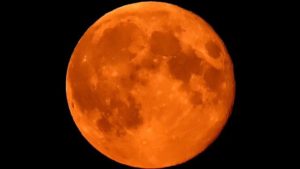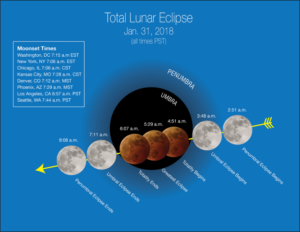By Rich Niccum, Education Services Manager

Credit: Wikipedia
The heavens have something extra-special lined up for us on the night of January 31, 2018. It will be an historic night you won’t want to miss, as this combination of astronomical events hasn’t happened since 1866.
Three different events will occur on the night of January 31. First there will be a super moon, our second in a month and third in a rare series of “super moons.” This occurs when the Moon is closer to Earth in its orbit. Not only will it appear larger but it will also appear brighter, about 14 percent brighter to be exact. The best time to view the supermoon will be right after sunset on the 31st. Get a good look though, because we won’t see another supermoon until January 2019.
Second, the moon will be called a blue moon because it is the second full moon this month. This is an alternative definition of a blue moon, one that was a mistake attributed to an amateur astronomer dating back to the 1940’s. You can find more about the two blue moon definitions here. This year we will have a double blue moon, one in January and one in March.
And lastly, as luck would have it there also will be a total lunar eclipse. A lunar eclipse happens as the Moon travels through what is called the Earth’s umbra. This is the dark core of the Earth’s shadow, and direct light is blocked from reaching whatever enters it. The Moon will not turn completely dark, though, as some sunlight still reaches the Moon’s surface indirectly by the Earth’s atmosphere. This filtered light reaching the Moon will give it a reddish tinge. Because of this red color, it is commonly called a blood moon. Depending on the atmospheric conditions at the time of the eclipse, the moon might also look yellow, orange or brown.


Credit: Wikipedia Commons
Here in eastern North America, we won’t get to see the eclipse from start to finish. With the eclipse beginning at 5:51 AM, and not entering the Earth’s umbra until 6:45 AM, we will have to catch a quick glimpse of the eclipse right before the moon dips below the western horizon around 7:00 AM. The best way to view the eclipse will be to get outside about 6:45 AM and find the highest point around you.
So, set your alarm early, grab a cup of coffee or hot chocolate, bundle up, and head to a high point near you about 6:45 AM. Look to the west-northwest, with the sunrise to your back, and watch a celestial event that happens even less then “once in a blue moon.”
If you would like to learn more about super moons and the lunar eclipse, check out a video produced by Science@NASA here.







